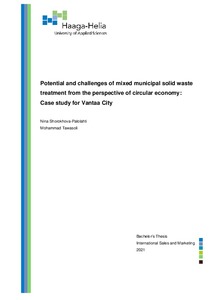Potential and challenges of mixed municipal solid waste treatment from the perspective of circular economy: Case study for Vantaa City
Shorokhova-Palolahti, Nina; Tawasoli, Mohammad (2021)
Shorokhova-Palolahti, Nina
Tawasoli, Mohammad
2021
All rights reserved. This publication is copyrighted. You may download, display and print it for Your own personal use. Commercial use is prohibited.
Julkaisun pysyvä osoite on
https://urn.fi/URN:NBN:fi:amk-202105108110
https://urn.fi/URN:NBN:fi:amk-202105108110
Tiivistelmä
The objective of this study is to identify potential and challenges of mixed municipal solid waste (MMSW) treatment from the perspective of circular economy based on the analysis of Vantaa’s MMSW treatment. This research paper also aims to understand how MMSW treatment in Vantaa City can be improved from the perspective of CO2 emissions and its economic value.
This thesis is commissioned by Vantaa City as a research, results of which can contribute into “the six-city strategy” (“6Aika”) project started in 2014 with a goal to strengthen cooperation of cities, businesses and research organizations in the field of circular economy, climate change mitigation and low-carbon footprint.
The thesis scope is limited by mixed municipal solid waste and ways of its treatment. Case study is narrowed to Vantaa City and characteristics of MMSW collected from Vantaa area.
Delimitation of this thesis relates also to emissions produced within the Vantaa City and direct emissions from Vantaa Energy related to energy recovery from mixed municipal solid waste.
The theoretical framework of this thesis includes concepts of a circular economy and waste treatment, in particular mixed municipal solid waste.
The methodological approach of this study was descriptive, and a qualitative method was used by conducting semi-structured interviews with open-ended questions to gather data. In total, experts from four different organizations participated in interview representing Vantaa City, Helsinki Region Environmental Services (HSY), Vantaa Energy and private Waste Management company.
Results of this study showed that incineration of waste with energy recovery is applied as a main method for Vantaa’s MMSW treatment. The main argument for this that it is economically efficient, can help to generate clean energy (heat and electricity), minimize landfilling of mixed municipal waste, and reduce GHG emissions. At the same time, it was highlighted that such waste treatment is out of the loop of circular economy and eliminates the possibility to inject the materials back into economy as secondary raw materials.
In conclusion, the findings showed that there are real opportunities regarding the possibilities for improvements in Vantaa’s MMSW treatment. Further cooperation with all stakeholders involved in the process as well as improvements in technology will help to utilize maximum value from Vantaa’s MMSW and speed up transition towards a circular economy.
This thesis is commissioned by Vantaa City as a research, results of which can contribute into “the six-city strategy” (“6Aika”) project started in 2014 with a goal to strengthen cooperation of cities, businesses and research organizations in the field of circular economy, climate change mitigation and low-carbon footprint.
The thesis scope is limited by mixed municipal solid waste and ways of its treatment. Case study is narrowed to Vantaa City and characteristics of MMSW collected from Vantaa area.
Delimitation of this thesis relates also to emissions produced within the Vantaa City and direct emissions from Vantaa Energy related to energy recovery from mixed municipal solid waste.
The theoretical framework of this thesis includes concepts of a circular economy and waste treatment, in particular mixed municipal solid waste.
The methodological approach of this study was descriptive, and a qualitative method was used by conducting semi-structured interviews with open-ended questions to gather data. In total, experts from four different organizations participated in interview representing Vantaa City, Helsinki Region Environmental Services (HSY), Vantaa Energy and private Waste Management company.
Results of this study showed that incineration of waste with energy recovery is applied as a main method for Vantaa’s MMSW treatment. The main argument for this that it is economically efficient, can help to generate clean energy (heat and electricity), minimize landfilling of mixed municipal waste, and reduce GHG emissions. At the same time, it was highlighted that such waste treatment is out of the loop of circular economy and eliminates the possibility to inject the materials back into economy as secondary raw materials.
In conclusion, the findings showed that there are real opportunities regarding the possibilities for improvements in Vantaa’s MMSW treatment. Further cooperation with all stakeholders involved in the process as well as improvements in technology will help to utilize maximum value from Vantaa’s MMSW and speed up transition towards a circular economy.
